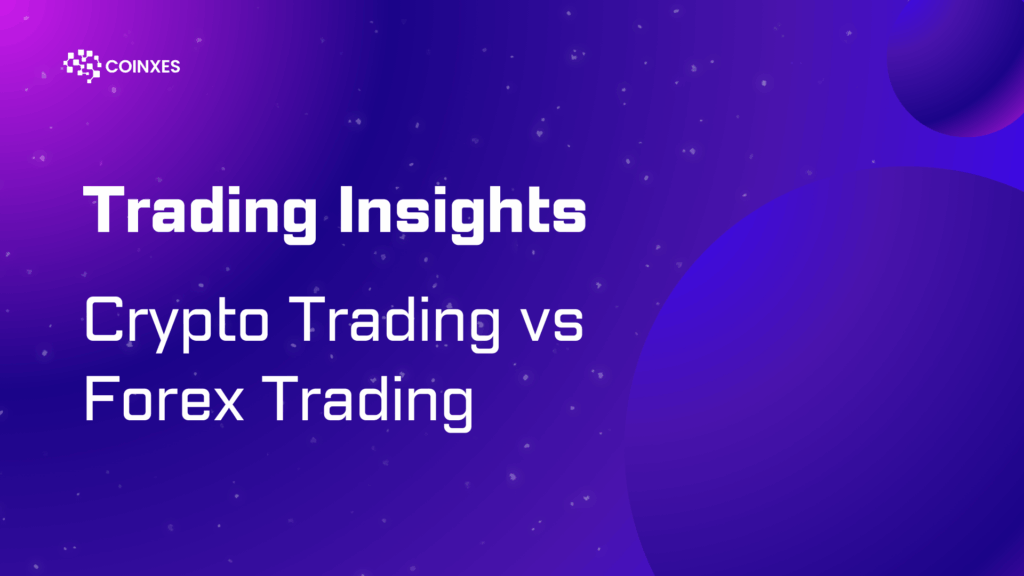Trading Insights: Crypto Trading vs Forex Trading
The rise of cryptocurrencies and the digital economy has reshaped global financial markets, giving traders new opportunities to profit from volatility. Meanwhile, foreign exchange (forex) remains the world’s largest market, with decades of institutional dominance. For traders weighing crypto trading vs forex trading, understanding their differences—and similarities—is critical. This article explores the pros, cons, and key factors to consider when choosing between these two dynamic markets.
Market Overview: Crypto vs Forex
1. Market Size and Liquidity
- Forex: The $6.6 trillion daily volume (2023) makes it the most liquid market globally. Major currencies like the EUR/USD and USD/JPY are traded 24/5 by institutions, banks, and retail traders.
- Crypto: The crypto market trades at $100–$300 billion daily, with Bitcoin (BTC) and Ethereum (ETH) dominating. Liquidity is concentrated on platforms like Binance and Coinbase, though smaller altcoins face volatility.
2. Trading Hours
- Forex: Open 24/5, with peak volatility during London (8 AM–4 PM GMT) and New York (12 PM–8 PM GMT) sessions.
- Crypto: 24/7 trading, with no central exchanges. Activity spikes during Asian and U.S. hours, but volatility persists round-the-clock.
3. Volatility and Risk
- Forex: Lower volatility compared to crypto, with currency pairs like EUR/USD typically fluctuating 0.5–1% daily.
- Crypto: Extreme volatility, especially in altcoins. Bitcoin can swing 5–10% in a day, while smaller coins see 20–30% intraday moves.
Key Differences: Crypto Trading vs Forex Trading
1. Regulatory Environment
- Forex: Regulated by agencies like the CFTC (U.S.), FCA (UK), and ASIC (Australia). Brokers must adhere to strict capital requirements and transparency rules.
- Crypto: Fragmented regulation. The SEC’s stance on Bitcoin ETFs, EU’s MiCA framework, and country-specific bans (e.g., China’s 2021 crackdown) create uncertainty.
2. Leverage and Margin
- Forex: Brokers offer high leverage (1:50 to 1:500+) for major pairs. This amplifies profits—but also losses.
- Crypto: Leverage options vary. Centralized exchanges (CEX) like Binance offer 1:100, while decentralized platforms (DEX) often limit leverage.
3. Trading Instruments
- Forex: Trade currency pairs, CFDs, and futures. Popular pairs include USD/JPY, GBP/USD, and AUD/USD.
- Crypto: Trade spot cryptocurrencies, tokenized assets, options, and derivatives (futures/contracts).
4. Technology and Accessibility
- Forex: Relies on traditional platforms like MetaTrader 5 (MT5) and TradingView. Algorithmic trading is common among institutional players.
- Crypto: Powered by blockchain and smart contracts. Traders use DEXs (Uniswap, PancakeSwap) and NFT-based platforms for decentralized access.
5. Costs and Fees
- Forex: Costs include spread (difference between buy/sell prices) and overnight swaps (for long/short positions).
- Crypto: Fees depend on network congestion and exchange rates. Gas fees on Ethereum and transaction fees on CEXs add to costs.
Advantages and Disadvantages
Crypto Trading Pros
- High Volatility: Greater profit potential in short timeframes.
- 24/7 Access: Trade anytime, with no session gaps.
- Decentralization: Reduced reliance on centralized authorities.
Crypto Trading Cons
- Regulatory Risks: Bans or restrictions can impact liquidity and value.
- Security Threats: Hacks on exchanges (e.g., FTX collapse) and scams persist.
Forex Trading Pros
- Lower Volatility: Easier to predict trends for long-term holds.
- Regulated Safety: Brokers are audited, reducing fraud risks.
- Liquidity: Narrow spreads on major pairs ensure quick entries/exits.
Forex Trading Cons
- Limited Hours: Closes on weekends, slowing profit opportunities.
- Geopolitical Sensitivity: Events like interest rate hikes or wars can cause sudden swings.
Strategies for Both Markets
Crypto Trading Strategies
- HODLing: Buy and hold for long-term growth (e.g., Bitcoin’s 10-year returns).
- Day Trading: Ride volatility with technical analysis (RSI, MACD).
- Algorithmic Trading: Use bots to execute rapid trades on decentralized platforms.
Forex Trading Strategies
- Position Trading: Hold for weeks/months, capitalizing on macroeconomic trends.
- News Trading: React to data releases (NFP, inflation reports).
- Carry Trading: Borrow low-interest currencies to invest in high-yield ones.
Emerging Trends to Watch
Crypto’s Institutional Growth
- ETFs: The approval of Bitcoin ETFs (e.g., ProShares) has brought mainstream investment.
- DeFi: Decentralized finance offers yield farming and lending opportunities.
Forex’s Digital Evolution
- AI Trading Tools: Platforms like eToro and Interactive Brokers integrate AI for predictive analytics.
- Micro Lot Trading: Allows retail traders to start with smaller stakes.
Cross-Market Opportunities
- Crypto-Forex Hybrids: Platforms like eToro let traders diversify into both markets.
- Stablecoins in Forex: USDT and USDC are used as hedging tools against fiat volatility.
Choosing Between Crypto and Forex
| Factor | Crypto Trading | Forex Trading |
| Volatility | High (5–10% daily) | Moderate (0.5–1% daily) |
| Regulation | Low (varies by region) | High (globally regulated) |
| Liquidity | Moderate (concentrated on top coins) | Extremely high (major pairs) |
| Leverage | Limited (1:100 max on CEX) | High (1:500+ on forex brokers) |
| 24/7 Trading | Yes (no downtime) | No (closes on weekends) |
| Best For | Risk-tolerant traders and tech enthusiasts | Long-term investors and macroeconomic traders |
FAQ: Crypto vs Forex Trading
Q1: Which is more profitable, crypto or forex?
- A: Crypto offers higher short-term profits due to volatility, but forex is better for steady, long-term gains.
Q2: Are forex brokers safer than crypto exchanges?
- A: Yes, forex brokers are regulated and insured. Crypto exchanges face higher fraud risks.
Q3: Can I trade both markets with one platform?
- A: Yes, platforms like eToro and MetaTrader 5 support forex and crypto pairs.
Q4: How do I minimize risk in crypto trading?
- A: Diversify holdings, use stop-losses, and avoid leveraged trading during extreme volatility.
Q5: Is forex trading dying due to crypto?
- A: No. Forex remains dominant in institutional trading, while crypto caters to tech-driven investors.
Conclusion: Your Choice Depends on Your Goals
Crypto trading is ideal for those seeking high-risk, high-reward opportunities and embracing blockchain innovation. Forex, with its stability and liquidity, suits traders focused on macroeconomic trends and long-term strategies. As the financial world evolves, hybrid approaches—combining both markets—could become the next frontier for traders.
